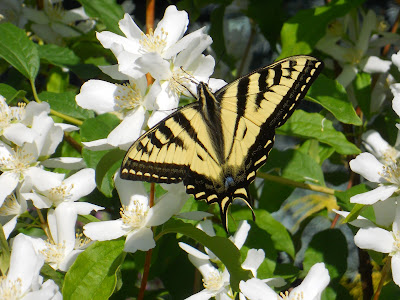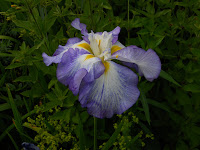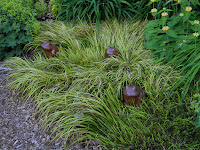A few of the plants that are in bloom in the gardens......Enjoy!
Saturday, July 30, 2011
Thursday, July 28, 2011
Lil Red Jewels
SPECIES PEONY
 I do not know what the actual species of this Peony is, but of course I forgot to see if there is a marker. I believe it was purchased at a Leach Botanical Garden sale about three years ago. The seed pod is fascinating in form. So when I was cleaning up the front garden a couple of weeks ago I came across the two pods, I thought I'll save them and see what they look like inside when they open. The pods open the other day and here's what I found inside. Blood red in color! I'm not sure what the other little cherry colored things are. Seeds that did not form? Anyway I would love to save the seeds and propagate them, but it would take 5 years before they would be blooming size. Anyone else up for it?
I do not know what the actual species of this Peony is, but of course I forgot to see if there is a marker. I believe it was purchased at a Leach Botanical Garden sale about three years ago. The seed pod is fascinating in form. So when I was cleaning up the front garden a couple of weeks ago I came across the two pods, I thought I'll save them and see what they look like inside when they open. The pods open the other day and here's what I found inside. Blood red in color! I'm not sure what the other little cherry colored things are. Seeds that did not form? Anyway I would love to save the seeds and propagate them, but it would take 5 years before they would be blooming size. Anyone else up for it?Monday, July 25, 2011
North America Native Except One
Odd, only one other Phlox is not native to North America out of the 67 species and it comes from Siberia, really? Another fact: all are perennials except one is an annual. I think Phlox is over looked due to the fact that they are summer bloomers and not in bloom when most gardeners are buying their first of the season plants. I have planted the garden varieties "Phlox paniculata" which are tall between 3' to 4', but there are also Alpines, Woodland, Prairie, and Creeping. I have never seen but a few other gardens that grow the tall variety.
Butterflies, Bumblebees and Hummingbirds find phlox irresistible, but its charms are not restricted to daytime pollinators. Moths may hover next to its blossoms from late afternoon to dusk. Night moths may be drawn to the flowers on summer evenings, as the sweet scent of phlox drifts across the garden. Although many phlox varieties are attractive to moths, those with pale-colored or white blossoms are true stars after dark.
One thing about phlox is they are not drought tolerant. Phlox likes fertile, organic-rich beds with good drainage and full sun. So how well do they do here at Beech Street, they do just fine. I think they can handle the conditions better than they let on.
One thing about phlox is they are not drought tolerant. Phlox likes fertile, organic-rich beds with good drainage and full sun. So how well do they do here at Beech Street, they do just fine. I think they can handle the conditions better than they let on.
USDA hardiness zone 4 to zone 8
Friday, July 22, 2011
Nice Shades
"PRIMA DONNA"
Coneflowers
Prima Donna has beautiful shades of pinks, purples, and oranges. It stands about 4' in height and needs no staking due to the very hardy stalks. Echinacea is an old fashioned prairie plant resembling the daisy with swept-back petals. They are happy flowers being hardy, drought tolerant, and long-blooming. Available in many different colors and flower styles of whites, yellows, pinks, corals, purples, and reds. The last couple years there have been some outstanding varieties introduced into the market. If you want to see collections of Echinaceas that you can to add to your gardens check out Terra Nova Nursery. They are the leaders of breeding the most varieties with color and flower interest.
USDA hardiness zone 3 to zone 9
Thursday, July 21, 2011
What's Up Tiger Lily?
No I'm not about to review a Woody Allen film..........I'm confused as to why you did not bloom last year. You were planted in the back garden 3 years ago and bloomed the first year. Nothing last year, not even a plant stock and I was bummed. This year there are 3 of you, so that's what I'm wondering and asking what's up Tiger Lily? What were you doing last year that you could not make the scene. Were you holding out for something? Was there something you wanted and I did not give you. Ask around the garden I really do not give to much in that department. You are quite beautiful, I'm glad you showed up and made your presents known.
 I'm one that does not start digging around in the beds to see what is going on with plants that do not return. If I had I would not have these beauties coming up this year. Sometimes you just have to let nature do what it is going to allow, sit back and enjoy what you get at the time.
I'm one that does not start digging around in the beds to see what is going on with plants that do not return. If I had I would not have these beauties coming up this year. Sometimes you just have to let nature do what it is going to allow, sit back and enjoy what you get at the time.
Lilium lancifolium which at one time was L. tigrinum, but you know how the botanical world is. Lets give one plant about 10 different names or change the name so not even the novice gardener has a clue as to what they are growing or looking for. No lets give a couple of plants the same name. Stop already. Anyway the Tiger Lily is native to northern and eastern Asia, including Japan. Grows to a height of 5' to 6' tall with wonderful downward facing recurved flowers of orange to red-orange in color with purple-black freckling. Maybe it should be called the Leopard Lily??????? Basic water needs, grows in any soil type, and needs full sun. It is one of the main species used in breeding of the Asiatic hybrids.
 I'm one that does not start digging around in the beds to see what is going on with plants that do not return. If I had I would not have these beauties coming up this year. Sometimes you just have to let nature do what it is going to allow, sit back and enjoy what you get at the time.
I'm one that does not start digging around in the beds to see what is going on with plants that do not return. If I had I would not have these beauties coming up this year. Sometimes you just have to let nature do what it is going to allow, sit back and enjoy what you get at the time. Lilium lancifolium which at one time was L. tigrinum, but you know how the botanical world is. Lets give one plant about 10 different names or change the name so not even the novice gardener has a clue as to what they are growing or looking for. No lets give a couple of plants the same name. Stop already. Anyway the Tiger Lily is native to northern and eastern Asia, including Japan. Grows to a height of 5' to 6' tall with wonderful downward facing recurved flowers of orange to red-orange in color with purple-black freckling. Maybe it should be called the Leopard Lily??????? Basic water needs, grows in any soil type, and needs full sun. It is one of the main species used in breeding of the Asiatic hybrids.
USDA hardiness zone 3 to zone 9
Wednesday, July 20, 2011
Did You Have A Good Day?
What a FABULOUS day it was today!!!!!!!!!!I spent the whole day working in the yard, trimming the shrubs that were getting out of control, and lopping up trees that needed to have lower limbs removed so the plants under them would do better. The front and side gardens are done and look outstanding if I say so. I spent about 6 hours and it was well worth it. Rain for tomorrow and that will be okay since I have to work.
Opuntias are quite an interesting plant due to the fact of it being the most successful cactus groups in terms of habitats conquered and geographic distribution. The most cold-tolerant of the lowland cacti and varying in size from 2" up to 50'+ as trees. The areas they live in are so vast, South America, Central America, North America, and Canada. I can not think of any other plant that you could see in so many other parts of the world. They have also been colonized in Europe, Australia, North and South Africa. There are three species that can be found in Oregon being Opuntia xcolumbiana, Opuntia fragilis, and Opuntia polyacantha. Most flower colors are a variety of yellows, but there are pinks, oranges, and reds.
Opuntias are quite an interesting plant due to the fact of it being the most successful cactus groups in terms of habitats conquered and geographic distribution. The most cold-tolerant of the lowland cacti and varying in size from 2" up to 50'+ as trees. The areas they live in are so vast, South America, Central America, North America, and Canada. I can not think of any other plant that you could see in so many other parts of the world. They have also been colonized in Europe, Australia, North and South Africa. There are three species that can be found in Oregon being Opuntia xcolumbiana, Opuntia fragilis, and Opuntia polyacantha. Most flower colors are a variety of yellows, but there are pinks, oranges, and reds.
USDA hardiness zone 3 to zone 12
Monday, July 18, 2011
Thursday, July 14, 2011
Wednesday, July 13, 2011
Monday, July 11, 2011
A Day of Beauty
WOW......what other plant gives so much as the Daylily. With over 60,000 registered cultivars, possibilities are amazing as to what colors or flower styles you can add to your gardens. Other flower traits that hybridizers developed include height, scent, ruffled edges, contrasting "eyes" in the center of a bloom, and an illusion of glitter which is called "diamond dust." Plus there is also evergreen and semi-evergreen. These photographs are a few that are blooming at Beech Street right now.
Sunday, July 10, 2011
Tiger Swallowtail Butterfly
I do not know if this peculiar butterfly is the same one I have seen for the last couple of weeks, but probably. It has been spending a lot of time here.............drinking nectar from the Mock Orange (see photograph), the Verbenas in the hanging baskets and many other flowers.

I read they lay eggs on Birch, Tulip, Aspen, and Lilac which are all planted here. A goal is to have butterflies breed here at Beech Street, I have had frogs breed in the bowls in the past, but this year it was Dragonflies. I find it fascinating to have all this wildlife here at Beech Street. When you have all this happening in your gardens it shows everything is balancing out to sustain life. What else is a garden for?
Friday, July 8, 2011
The Martagons
Sounds like we have new neighbors that moved in...........
 I was surprised by the fact that the top photograph is a group I planted last fall and had no idea they were white. They are planted in the side garden under the Clerodendrum tree and the lilacs are planted under the big Cherry tree in the back garden.
I was surprised by the fact that the top photograph is a group I planted last fall and had no idea they were white. They are planted in the side garden under the Clerodendrum tree and the lilacs are planted under the big Cherry tree in the back garden.
 They are the sweetest little flowers, about 3" across if even that. The fact that the flower re-curves back is what I like about the look of them. It took a couple of years for the lilac ones to become established before they bloomed, I think it was about three years. Most people would not wait that long for a bulb to bloom. But now this stand of them is over 15 years old........They say there are groups of them in Europe that are hundreds of years old. Martagons are a group of lilies that have been in cultivation since the 1500's. So I would say they are worth growing.
They are the sweetest little flowers, about 3" across if even that. The fact that the flower re-curves back is what I like about the look of them. It took a couple of years for the lilac ones to become established before they bloomed, I think it was about three years. Most people would not wait that long for a bulb to bloom. But now this stand of them is over 15 years old........They say there are groups of them in Europe that are hundreds of years old. Martagons are a group of lilies that have been in cultivation since the 1500's. So I would say they are worth growing.
 I was surprised by the fact that the top photograph is a group I planted last fall and had no idea they were white. They are planted in the side garden under the Clerodendrum tree and the lilacs are planted under the big Cherry tree in the back garden.
I was surprised by the fact that the top photograph is a group I planted last fall and had no idea they were white. They are planted in the side garden under the Clerodendrum tree and the lilacs are planted under the big Cherry tree in the back garden. They are the sweetest little flowers, about 3" across if even that. The fact that the flower re-curves back is what I like about the look of them. It took a couple of years for the lilac ones to become established before they bloomed, I think it was about three years. Most people would not wait that long for a bulb to bloom. But now this stand of them is over 15 years old........They say there are groups of them in Europe that are hundreds of years old. Martagons are a group of lilies that have been in cultivation since the 1500's. So I would say they are worth growing.
They are the sweetest little flowers, about 3" across if even that. The fact that the flower re-curves back is what I like about the look of them. It took a couple of years for the lilac ones to become established before they bloomed, I think it was about three years. Most people would not wait that long for a bulb to bloom. But now this stand of them is over 15 years old........They say there are groups of them in Europe that are hundreds of years old. Martagons are a group of lilies that have been in cultivation since the 1500's. So I would say they are worth growing.
USDA hardiness zone 3 to zone 10
Friday, July 1, 2011
Visiting a Friend's Garden
A couple of weeks ago Will & I were invited out to Barbara Blossom Ashmun's home to see the gardens. It is always a treat to visit her and the wonderful plants she has charmed into growing in her flower beds.










 And a Parade of Irises
And a Parade of Irises










 And a Parade of Irises
And a Parade of IrisesBarbara is an author, an accomplished writer for the Portland Tribune & Fine Gardening magazine, and has her own blog titled Garden Muse............
Subscribe to:
Comments (Atom)
















































